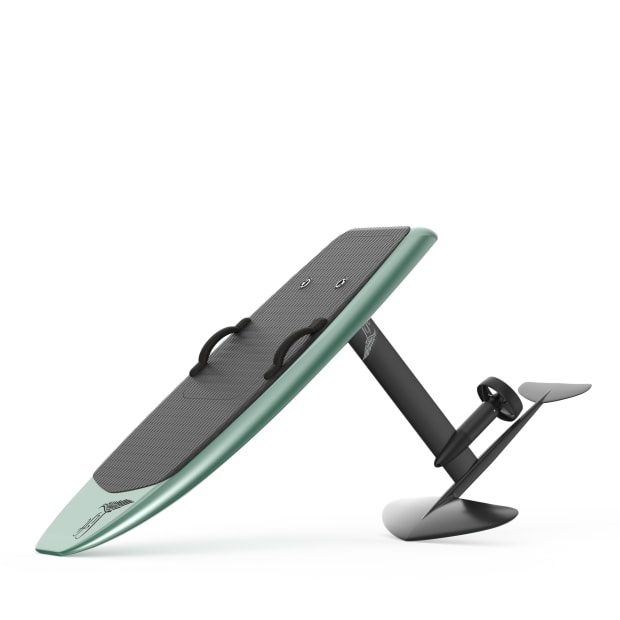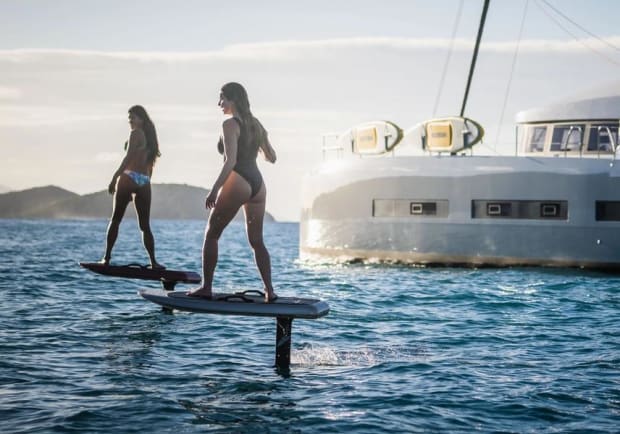Surfing just got cooler and faster with Lift4, an e-foiling surfboard that can shred local waterways with or without waves.
If you've gawked at surfers zipping around on a shortboard that hovers above the water at your local beach, odds are good it's from Lift Foils. The brand has carved a name for itself in the outdoor space for crafting hydrofoil and electric hydrofoil surfboards, and its latest innovation is Lift4.
Lift's eFoils are effectively the world’s smallest personal watercraft—and also some of the quietest and most environmentally friendly. We took Lift4 for a test ride. Here's everything you need to know.

Courtesy Image
What Is an eFoil Surfboard?
The brand's eFoil surfboards are powered by an electric prop on a hydrofoil that propels it out of the waves to cruise smoothly through water. These lofty new surfing machines work via a handheld remote control (don't worry, it floats!) and can reach speeds of 30mph.
The brand originally produced carbon-fiber racing SUPs and hydro-foiling kiteboards, but found itself at a crossroads.
“We were interested in foiling technology and knew we wanted to grow our customer base, but balancing on a foil while flying a kite is hard—and we thought it would be much easier with a motor,” recalls Lift Foils' founder Nick Leason, who rejiggered the whole operation and came up with the eFoil—an electric-powered foiling surfboard.
"They didn’t exist in the world at that point," says Leason. "It’s funny how life works. Sometimes you gotta burn it all down to find your true purpose.”
Since then, the company has built and released several models, including Lift4, which debuted this past March. The board comes in a variety of sizes and is built from carbon fiber, epoxy, and foam coring, while the foil is all carbon fiber.
Carbon fiber, of course, has been all the rage for quite some time in various racing sports, but Leason feels his company has a special edge.
“We have 65 employees, plus some off-sites, and we build the boards and do all the carbon-fiber finishing ourselves,” he says. “We have the same process as Lamborghini," he adds, hesitant to get into any specifics.
Lift4 is a departure from the previous Lift3 in that its lithium battery—specifically engineered for the challenging saltwater environment—is now stronger. It can fully charge in under an hour and offers a two-hour ride time. The new board is built to be quieter than its predecessor, and has also been adjusted for a more stable ride.

Courtesy Image
How to eFoil
I gave the Lift Foils a kick in the tires in the warm, shallow waters of the IntraCoastal Waterway off Riviera Beach, FL, just north of Palm Beach. One of Lift Foils' goals is to have its customers up and riding after a single lesson. I admit I had my doubts going in, or at least I didn’t want to embarrass myself. I’m 41, with a background in snowboarding and surfing, but it’s been a minute.
After a brief dry-land training session with an instructor going over the do's and don’ts of throttle control, a few safety measures, and the basics of popping up on the board, we were off. I jumped into the water, hiked myself onto the board, and immediately ran aground. It’s easy to forget looking at one of these things that they actually draw 28 inches. Freeing myself, I was soon off again—this time for real.
At first, I rode the Lift Foils like a boogie board, getting a feel for the throttles while weaving through anchored barges and some buoys. The board felt reassuringly stable, and soon I was up on my knees, which is the next recommended position for novices. Perched on my knees on a hard board in a bit of chop was a not-so-gentle reminder that I had knee surgery over Christmas, so I decided to bite the bullet and stand up.
It was shockingly easy, and my fears were assuaged. Darting around the waterway near small boats filled with drunken 3 p.m. South Florida revelers, I kept my weight forward as instructed and tried to keep my body loose, digging my toes into the board like a yogi. It really does feel a lot like snowboarding.
Once I got comfortable with my balance, I gave the throttle a little more juice. Then I was really flying. That's literally the sensation you get as the board lifts up out of the water onto its foil. I'm guessing that for many, this alone will be well worth the steep-ish price of admission. Boards start at around $9,000 and can run above $14,000, depending on the model.
My 4-year-old has been watching the old Disney Peter Pan movie, and that’s what I was reminded of as I zipped over the water. I was weightless but could also feel every ounce of my weight shifting.
Once the board is out of the water, things aren't quite as easy when skimming the surface. Turning to avoid a barge, I took a bracingly hard, face-first fall into the drink. Luckily, nobody on the party boats seemed to notice—and it was a quick recovery. The board ground to a halt a few feet away. Climbing back on, I was back up and flying like a bird again.
Nitpick
The price tag may seem tough to swallow at first, but easier when you think of Lift Foils less as a board and more as a personal watercraft. Also, that fall I took was hard, and I can see it scaring some people away. But you’re falling into water—and as long as you don’t gun the prop as you fall, this toy feels very safe. I’d call this ride a qualified risk worth the reward.
[From $12,000; liftfoils.com]
from Men's Journal https://ift.tt/rVz0m9E


0 comments